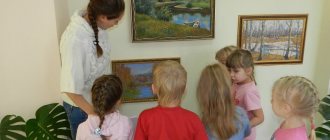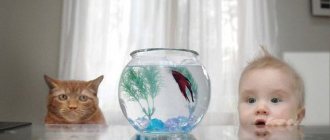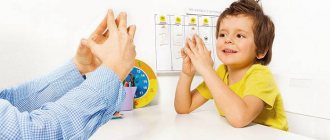The role of environmental education in the development of the personality of a preschool child
Today, the topic of ecology and reasonable consumption is more relevant than ever. Taking care of the environment has become not only useful, but also important. Now they are trying to instill eco-values from childhood - educational methods and classes on the topic of an eco-friendly lifestyle and caring for the environment are being actively introduced in preschool institutions.
The role of environmental education in the life of a preschooler is unfairly underestimated. Nevertheless, it is in childhood that all the fundamental knowledge and principles of human life are acquired. Thus, we can summarize the fact that environmental education is an extremely serious and important thematic block in the program of any preschool institution.
A modern specialist must help children form their own, accessible to them, scientific picture of the world, an idea of the role of man in this world and his relationship with the environment.
The process of children's eco-education is particularly emotional - children perceive nature as something living. This aspect allows you to interest a child in completely different ways - sounds, tactile sensations or smells will make even the most hyperactive child stop, take a closer look and think.
Such an integrated approach reveals to children the beauty of nature and teaches them to notice it, fosters a humane attitude towards its inhabitants, and also forms a system of environmental knowledge and ideas.
For eco-education to be productive, it is necessary to create a special environment where the teacher will prove by personal example the importance and seriousness of the topic. This could include group trips to parks and squares, watching educational films and cartoons, and educational games on the topic of environmentally friendly consumption. During one of the classes, the teacher can talk about how to properly sort waste and why it is needed. Visually sorting waste will help teach a child “smart consumption,” not to mention the fact that children themselves will be able to take part in the action. Such an experience will allow children to understand that we are all together, and each of us individually, is responsible for the planet, and everyone can preserve and increase its resources.
The teacher plays a key role in the environmental education of a child. In the process of work, it is recommended to use different formats that must be successfully integrated into any child’s activity. To do this, the teacher can use both methodological literature and music, as well as fiction and games.
The latter, in turn, are the most popular and effective format of eco-education. There are several types of didactic games: board games, games with objects and word games. The first class of games is aimed at developing the child’s thought processes: analysis, synthesis, classification and generalization. The second class is games with various natural materials and shapes: leaves, water, cones. Such games can use a wide variety of materials that are within walking distance. After all, nature is what surrounds us. The third class of games is aimed at developing attention, reaction speed and coherent speech. It’s easy to “green” such games ahead of schedule; the main thing is to decide on the context.
Don’t forget about another format of eco-education – excursions. On excursions, children get acquainted with representatives of flora and fauna, which contributes to the formation of basic ideas about the relationships in nature. This format of classes will help the child develop observation and interest in the natural processes of life.
Of great importance in environmental education is the practical part - conducting experiments and experiments. Here the child will be able to use all senses, this will allow him to immerse himself as fully as possible in the problem presented. After such an observation, it is necessary to conduct a summary conversation with the children. Here the teacher needs to use various forms of communication: story, description, dialogue.
And last, but not least, an important factor in the environmental education of children is the lifestyle of parents. The teacher needs to motivate parents to consume wisely and protect the environment. You can start small, for example, when your family goes out into nature, parents must remove all waste and recycle it. In this way, the child will consolidate the useful habits learned in kindergarten.
Reflecting on the role of eco-education in the life of a preschooler, we came to the following conclusion: the effectiveness of education depends not only on the child’s knowledge and behavior in nature, but also on his direct participation in preserving and increasing natural benefits. The teacher and parents are called upon to provide the practical part of education. Thus, only a systematic approach to environmental education can have a huge impact on the child and his attitude towards the environment.
Work on the formation of an ecological culture in preschool children
So, from about 4–5 years old, children are ready for a conscious perception of environmental principles. How can we, as parents, contribute to this?
Children's thinking at this stage still remains objective and visual. Therefore, when building your own methodology of environmental education, it is necessary to include the following important forms of work.
- Trips to nature (to the forest, to a meadow, to a river beach), during which the child will not only observe the life of plants and animals, but will learn to appreciate the beauty of nature, from the example of his parents he will learn to take care of it, and will be able to learn a lot of new things from adults .
- Work on the site (in the vegetable garden, orchard, at the dacha), when a preschooler learns creative activity, can evaluate the result of this work, and forms an understanding of how important it is to take care of the surrounding nature.
- Caring for living pets (cat, dog, parrot, fish), which instills in the child love for our smaller brothers, teaches responsibility towards them and compassion.
- Caring for indoor plants, giving you the opportunity to observe their growth and development, learn the patterns of vegetation and understand your own role in this.
- Family environmental events (clean-up work, planting trees, creating flower beds, hanging feeders), instilling hard work and a caring attitude towards the environment.
- Nature calendars or observation diaries, where the baby, together with his parents, will enter data about changes in nature that occur throughout the year.
At the same time, the role of parents in the formation of a child’s environmental culture comes down not only to the role of mentors who set an example. During such work, adults teach children important things:
- humane interaction with the outside world, environmental activities;
- the ability to analyze observed processes;
- deduce patterns of natural development, draw conclusions;
- make basic predictions about the consequences of certain human actions.
Advice
Arrange environmental exhibitions at home, where the child’s independent work or joint work with parents will be presented (crafts made from natural materials, thematic drawings made by the child personally or together with parents). They can be organized, for example, for such environmental holidays as:
- Spring Day (March 1);
- Earth Day (March 20);
- Vernal Equinox Day (March 20);
- Bird Day (April 1);
- World Sun Day (May 3).
Or for national holidays:
- Ivan Kupala;
- Elijah's day;
- Fedorin's day, etc.
Such exhibitions will increase the child’s interest in environmental issues and help appreciate the beauty of nature. And if you also introduce your child to these holidays and folk beliefs, you will significantly enrich his horizons. This is a very useful educational element both for younger preschoolers (then the emphasis will be on creativity together with you) and for older ones (more independence).
What does this look like in practice?
Behind all these seemingly sophisticated concepts lies a daily work that is invisible to the child. The peculiarities of the formation of thinking, as we remember, at this age are expressed by objectivity and clarity. Therefore, when going for a walk or going into nature, parents ask the child to evaluate what changes in nature have occurred recently (flowers have bloomed, dandelions have turned grey, chicks are chirping in the trees, it has become slushy, birds have flown away, snow has fallen, etc. ).
Working in the garden or vegetable garden, the child gains knowledge about what period of the year what work should be done in order for flowers to bloom, fruits and vegetables to ripen. At the same time, you can explain to him why butterflies flying around, beetles, ants, birds are needed, what their benefits and relationships are. Tell them that they all have their own home, their parents have kids that they take care of and are very worried when something happens to them - just like people.
By their example, adults show a creative attitude towards nature (water, feed, loosen), explain that squashing bugs, catching butterflies, breaking branches just like that is inhumane (and they themselves do not do this). At the same time, you can touch the grass, smell the flowers, enjoy the singing of birds, observe the changes that occur every day (this is where the calendar comes in handy), and draw conclusions about the laws of nature.
During family environmental events, children will learn what trees are for, why it is so important to take care of them, why one should not litter the environment with waste, and how important it is to feed the birds in the garden, yard, and park in winter.
It’s good if the child starts asking a lot of questions about this in order to expand the range of existing knowledge and systematize the information received.
Advice
If your baby doesn’t bombard you with “why” questions, ask him yourself. Provoke your child to think, compare, and draw conclusions. (Why do you think the sunflower closed its cap? Why is the berry in the sun already red, but under the leaf not yet? What will happen if bees don’t fly into our garden? Why do trees shed their leaves?). Find answers together. This is a good tool not only for environmental education, but also for the development of preschoolers’ speech.
When a child takes care of an indoor flower or animal, adults also teach him to create, preserve, and help. Their stories, accompanied by visual, lively pictures, are not perceived by the child as teaching. This is a natural process. The formation of environmental consciousness in preschool childhood should take place unnoticed.
Reading is the best learning
Preschool age is the time when reading books evokes the most vivid emotional response in a child, makes you empathize and think about what you read. The conclusions drawn after reading the book remain in the child’s memory for a long time.
Literature on environmental education is, first of all, the works of V. Bianchi. In the form of entertaining stories or fairy tales, they help the child understand complex natural phenomena, the patterns of the natural world, talk about the interaction of the organism with the environment, and the forms of its adaptation to its habitat.
You can also tell a preschooler about the beauty and diversity of native nature using the examples of the works of M. Prishvin, F. Tyutchev, A. Pushkin, A. Fet, K. Ushinsky, N. Nekrasov, L. Tolstoy, N. Sladkov and others.
Reading children's encyclopedias devoted to natural areas, climate, animals, and plants will also be useful in terms of improving environmental education. Bright pictures in them contribute to more effective memorization of accurate information. But fairy tales, proverbs and sayings, which can also be classified as “ecological”, carry figurative information, which is also useful.
Raising a child begins in the family. The harmonious development of children in the future depends on how correct it is. In environmental terms, too.
The best means of education is play
This is true. Gaming activities develop, educate, teach. At the same time, it is fun, interesting, without coercion. So the development of a child through didactic games is one of the most effective means of teaching environmental (and any other) literacy.
The game can be played both during walks and outside.
In the first case, a preschooler can study the appearance and properties of earth, water, clay, sand, ice, and snow. For example, you can offer your child:
- play snowballs;
- To make a snowman;
- hold the ice in your hands, breathe on it;
- make a sun or a tower out of ice floes;
- make Easter cakes from sand;
- compare clay and earth by touch;
- make bricks from clay;
- pass water mixed with clay through a layer of sand;
- compare how sand and clay behave in water, etc.
In the second case, you can arrange a family game at home, inviting friends to visit. These could be, for example, games in the form of lotto:
- What grows where?
- Who lives where?
- Who eats what?
In this case, you need to choose among the lotto cards those that correspond to the environment depicted on each card.
Games in the form of quizzes:
- find by description (you need to find a picture that matches the description of a bird, animal, season);
- recognize and name (recognize an animal or bird by sounds, tracks);
- when does this happen (determine the time of year, natural phenomenon from the description).
There are many educational games on ecology. You can throw a ball to a child, naming a general class (for example, pets), and in response the child, having caught the ball, must give an example. You can arrange a competition to see who can best draw what is described on the card in text format. Or divide the children into 2 groups and ask them to unite in such a way that the upper parts of the plants in the pictures of some coincide with the lower parts of the pictures of others (tops and roots). You can ask kids to imitate the movements of the birds or animals shown in the picture. Or ask them to remove an extra link in some chain of images...




